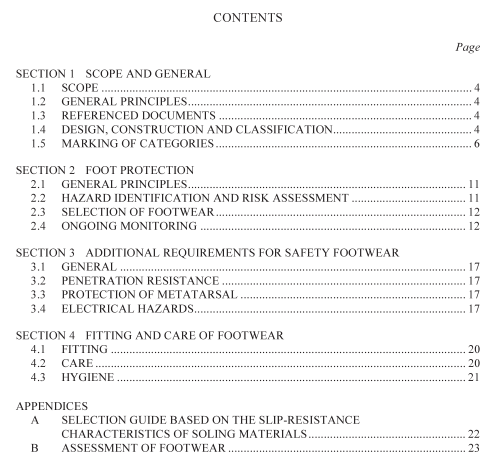AS NZS 2210.1 pdf download – Safety, protective and occupational footwear Part 1: Guide to selection, care and use

AS NZS 2210.1 pdf download – Safety, protective and occupational footwear Part 1: Guide to selection, care and use
2.1 GENERAL PRINCIPLES In order for footwear to be effectively worn, it is useful to develop an educational program to meet the needs of the user and the specific environment. Unless people are made familiar with the several factors about foot injuries and the actions necessary to prevent these injuries, they may not become sufficiently enthusiastic to ensure proper footwear is worn and other risk control measures instituted. This should ensure the cooperation of the employees, who should be aware of their responsibility to—
(a) not willfully damage or misuse the protective footwear provided;
(b) immediately report any loss or damage affecting the footwear’s performance; and
(c) understand the need for care and maintenance to actively ensure continued maximum protection of the footwear. Information should also be provided to each wearer of protective footwear on issues such as the need to—
(i) keep feet and footwear clean;
(ii) wash and thoroughly dry feet daily; and
(iii) change socks daily.
2.2 HAZARD IDENTIFICATION AND RISK ASSESSMENT As protective footwear can only provide the wearer with a limited degree of protection against hazards in the workplace, it is essential that a hazard analysis study be carried out before implementing a footwear protection program. An example of a hazard identification/risk assessment sheet is shown in Table 2.1. Common workplace hazards include the following:
(a) Slipping—see Appendix A.
(b) Mechanical—falling objects, sharp or penetrating objects (puncture/penetration), moving plant, machinery/equipment cutting, crushing/compression machinery/equipment ejecting objects (metatarsal impact).
(c) Hazardous substances—gas, flammable materials, corrosives, toxic substances, infectious agents (chemically resistant, waterproofing). (d) Thermal—extreme cold, extreme heat, splashes of hot or cold materials;
(e) Electrical—unsafe electrical equipment, e.g. worn cords, water near electrical equipment (electrical insulation).
(f) Static electricity—static discharge may cause harm to workers or equipment. Prior to the selection of protective footwear, a hazard assessment and analysis should be conducted. This assessment is based upon the workplace environment and specific work activities.
The following potential hazard areas should be considered:
(i) Materials handled by the employee during the normal course of his/her job, in order to—
(A) evaluate the risk of objects falling onto or striking employees’ feet;
(B) consider any material or equipment that might roll over employees’ feet; and
(C) consider any sharp or pointed objects that might cut the top of employees’ feet.
(ii) Foreign objects that may penetrate the bottom or side of the foot.
(iii) Exposure to corrosive or irritating substances.
(iv) Exposure to explosive atmosphere: evaluate the risk of static electrical discharges igniting an explosion of fire.
(v) Risk of damage to sensitive electronic components or equipment due to the discharge of static electricity.
NOTE: Check with protective footwear suppliers or manufacturers regarding the level of electrical resistance provided by the footwear.
(vi) Risk of coming into contact with energized conductors.
(vii) Risk to ankles from uneven walking surface or rough terrain (in which case ankle support is required).
2.3 SELECTION OF FOOTWEAR The environment in which the footwear is intended to be used should be considered carefully. After a hazard identification as in Table 2.1, consideration should be given to the types of footwear available, to select the combination of footwear type, sole material, tread design and upper design and materials best suited to the application in question— see Table 2.2.
Some specific workplace hazards may fall outside the scope of a product specification. It should be noted that new materials and new technology being incorporated into footwear e.g. non-metallic toecaps or midsole protection, may perform differently to traditional materials and this may need to be taken into account when considering footwear. Where slippery surfaces are a commonly encountered hazard, see Appendix A. Some working environments, e.g. forestry work or mining, may require special purpose footwear which may incorporate features (such as cleats or spikes) or be waterproof. If there is doubt concerning the selection of suitable protective footwear, advice should be sought from a competent person, the footwear supplier or manufacturer.
2.4 ONGOING MONITORING Hazard identification and risk assessment should be an on-going activity in the employer’s safety program. This will ensure that risks are constantly re-evaluated and that the level of protection is maintained. Assessment should be documented and filed for easy reference. The effectiveness of the foot protection against the hazards encountered in the workplace should be continually monitored, as the hazards may change over time. In addition, the needs of individual workers may change and the working environment may present challenges according to the season or activity.









